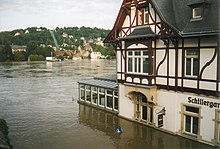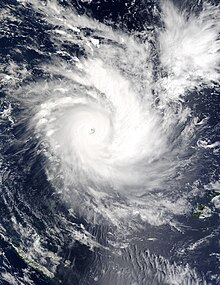Weather of 2002

The following is a list of weather events that occurred on Earth in the year 2002. There were several natural disasters around the world from various types of weather, including blizzards, cold waves, droughts, heat waves, tornadoes, and tropical cyclones. The deadliest disaster was a heat wave in India in May, which killed more than 1,030 people. The costliest event of the year was a flood in Europe in August, which killed 232 people and caused €27.7 billion (US$27.115 billion) in damage. In September, Typhoon Rusa struck South Korea, killing at least 213 people and causing at least ₩5.148 trillion (US$4.2 billion) in damage.
| Weather year articles (2000–2009) |
|---|
| 2000, 2001, 2002, 2003, 2004, 2005, 2006, 2007, 2008, 2009 |
Winter storms and cold waves[edit]
In October, Cyclone Jeanett killed 33 people when it moved across Europe.[1]
In December, an ice storm affected North Carolina, killing 24 people.[2]
Droughts, heat waves, and wildfires[edit]
In May, a heat wave in India killed more than 1,030 people.[3]
A drought affected much of North America.
Floods[edit]
In February, flash floods affected the Bolivian capital city La Paz, killing 69 people.
On March 31, flash floods in the Canary Islands killed eight people and left €20 million in damage.[4]
In June, floods in northern Chile killed 17 people.
In August, widespread floods occurred throughout Europe, killing 232 people. The floods and €27.7 billion (US$27.115 billion) in damage.[5]
Tornadoes[edit]
There were 934 tornadoes in the United States alone, collectively resulting in 55 deaths.[6][7] A tornado outbreak in November killed 36 people.
Tropical cyclones[edit]

The year began with Tropical Storm Cyprien developing near Madagascar, Cyclone Bernie developing off Northern Australia, Cyclone Waka moving away from Tonga, and a weak tropical depression near the Solomon Islands.[8][9][10] There were a further 15 tropical cyclones in the south-west Indian Ocean in the year, including Cyclone Dina, which caused 15 deaths in the Mascarene Islands, and Cyclone Kesiny, which killed 33 people in Madagascar.[8] The year ended with Tropical Storm Delfina moving ashore Mozambique.[8][11][12] In the Australian region, nine tropical cyclones developed in the year after Bernie, including powerful Cyclone Chris which struck Western Australia.[11][13] In the South Pacific, there were 16 tropical cyclones that developed after Waka. The year ended with Cyclone Zoe moving away from Fiji, three days after it became the second-most intense tropical cyclone on record within the Southern Hemisphere.[14][11][15]
The first storm to develop in the northern hemisphere was Tropical Storm Tapah on January 9 east of the Philippines. There were a total of 36 tropical cyclones that year. Among the storms were Typhoon Rusa, which was the most powerful typhoon to strike South Korea in 43 years, and which caused at least 213 fatailties and ₩5.148 trillion (US$4.2 billion).[16][17] Tropical Storm Kammuri killed 153 people in China.[18] Mudslides caused by Typhoon Chataan killed 47 people in the Federated States of Micronesia, becoming the deadliest natural disaster in the history of Chuuk State.[19] In the North Indian Ocean, there were seven tropical cyclones, beginning with a cyclonic storm that struck Oman in May.[20] In November, a cyclonic storm struck West Bengal, killing 173 people.[21] There were 19 tropical cyclones in the eastern Pacific, including three Category 5 hurricanes – Elida, Hernan, and Kenna. The last of the three, Kenna, also struck southwestern Mexico.[22] In the Atlantic Ocean, there were 14 tropical cyclones, nine of which formed in September, including hurricanes Isidore and Lili which moved through the Caribbean and into the southern United States.[23]
References[edit]
- ^ "Munich Re NatCatSERVICE: Natural catastrophes 2002" (PDF). Munich Re. 30 December 2002. Retrieved 14 November 2017.
- ^ "USATODAY.com - Worst ice storm in years devastates the Carolinas". Archived from the original on 2013-02-03. Retrieved 2013-01-31.
- ^ "Heat wave in India kills 1,000 people this week". CBC News. 2002-05-22.
- ^ "THE 31 MARCH 2002 STA. CRUZ DE TENERIFE FLASH FLOOD: CHARACTERISTICS AND DIFFERENCES WITH SIMILAR EPISODES" (PDF). Retrieved 2023-10-31.
- ^ "Large floods in Europe, 1985–2009" (PDF). Hydrological Sciences Journal. Retrieved 2023-10-31.
- ^ "U.S. Annual Tornado Maps (1952–2011): 2002 Tornadoes". Storm Prediction Center. National Oceanic and Atmospheric Administration. Retrieved May 14, 2015.
- ^ "Annual U.S. Killer Tornado Statistics". Storm Prediction Center. National Oceanic and Atmospheric Administration. Retrieved January 18, 2016.
- ^ a b c Cyclone Season 2001–2002. RSMC La Reunion (Report). Météo-France. Archived from the original on October 18, 2014. Retrieved 2012-11-26.
- ^ "IBTrACS - International Best Track Archive for Climate Stewardship". ibtracs.unca.edu. Retrieved 2022-01-25.
- ^ Jonty D. Hall (2004). "The South Pacific and southeast Indian Ocean tropical cyclone season 2001–02" (PDF). Australian Meteorology Magazine. 53 (4). Queensland Regional Office, Bureau of Meteorology, Australia: 285–304. Archived from the original (PDF) on July 6, 2011. Retrieved December 5, 2010.
- ^ a b c "Southern Hemisphere 2002-2003 Tropical Cyclone Season Review". australiasevereweather.com. Retrieved 2022-01-25.
- ^ "IBTrACS - International Best Track Archive for Climate Stewardship". ibtracs.unca.edu. Retrieved 2022-01-25.
- ^ Joe Courtney (2002). "Tropical Cyclone Chris Tropical Cyclone Report" (PDF). Perth Tropical Cyclone Warning Centre. Australian Bureau of Meteorology. Retrieved 10 December 2010.
- ^ "Southern Hemisphere 2001-2002 Tropical Cyclone Season Review". australiasevereweather.com. Retrieved 2022-01-25.
- ^ "Tropical Cyclone Winston Makes Category 5 Landfall; Strongest on Record in Fiji | The Weather Channel - Articles from The Weather Channel | weather.com". The Weather Channel. Retrieved 2022-01-25.
- ^ "Northern Hemisphere 2002 Tropical Cyclone Season Review". australiasevereweather.com. Retrieved 2022-01-25.
- ^ Kim, Yong-kyun; Sohn, Hong-Gyoo (2017-07-11). "Disasters from 1948 to 2015 in Korea and Power-Law Distribution". Disaster Risk Management in the Republic of Korea. Disaster Risk Reduction: 77–97. doi:10.1007/978-981-10-4789-3_3. ISBN 978-981-10-4788-6. PMC 7123863.
- ^ International Federation of Red Cross and Red Crescent Societies (2002-09-03). China: Flash Floods Appeal No. 16/02 Operations Update No. 4 (Report). ReliefWeb. Retrieved 2012-10-15.
- ^ International Red Cross and Red Crescent Movement (2002-07-04). Federated States of Micronesia: Typhoon Chataan Information Bulletin No.01/2002 (Report). ReliefWeb. Retrieved 2012-06-27.
- ^ Economic and Social Commission for Asia and the Pacific (2003-03-10). "2002 Annual Tropical Cyclones Review" (PDF). World Meteorological Organization. Archived (PDF) from the original on 2016-03-03. Retrieved 2008-07-15.
- ^ Disaster List. Université Catholique de Louvain (Report). EM-DAT: The OFDA/CRED International Disaster Database. Archived from the original on February 3, 2014. Retrieved October 16, 2013.
- ^ Franklin, James L.; Avila, Lixion A.; Beven, John L.; Lawrence, Miles B.; Pasch, Richard J.; Stewart, Stacy R. (2003-10-01). "Eastern North Pacific Hurricane Season of 2002". Monthly Weather Review. 131 (10): 2379–2393. Bibcode:2003MWRv..131.2379F. doi:10.1175/1520-0493(2003)131<2379:ENPHSO>2.0.CO;2. ISSN 1520-0493.
- ^ Pasch, Richard J.; Lawrence, Miles B.; Avila, Lixion A.; Beven, John L.; Franklin, James L.; Stewart, Stacy R. (2004-07-01). "Atlantic Hurricane Season of 2002". Monthly Weather Review. 132 (7): 1829–1859. Bibcode:2004MWRv..132.1829P. doi:10.1175/1520-0493(2004)132<1829:AHSO>2.0.CO;2. ISSN 1520-0493.
| Global weather by year | ||
|---|---|---|
| Preceded by 2001 |
Weather of 2002 |
Succeeded by 2003 |
